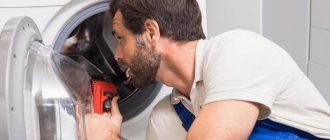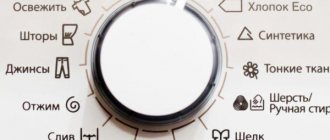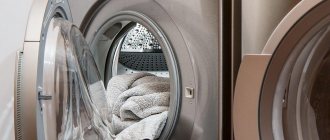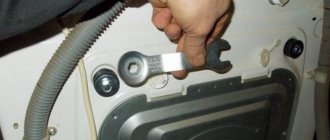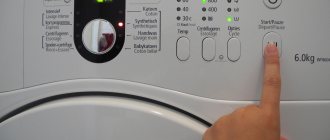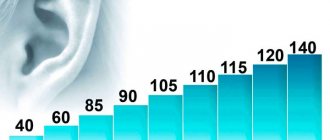Published: 20 Dec 2020
You threw things into the washing machine, turned on the wash and forgot about it for a while, because the automatic equipment does not require attention until the end of the work. But this time, when you went to the washing machine to take out and hang up the clean clothes, you discovered that the washing machine had frozen.
The washing machine can stop at any time, both at the beginning and at the end of the wash; it can stop during rinsing or when it starts spinning. In most cases, equipment owners turn to us for help when the SMA freezes during the spin cycle.
Simple faults
During the washing process, the washing machine may freeze and stop. There are various reasons for equipment failures. Next, we will consider the most common causes of simple machine failures.
The weight of the laundry exceeds the norm
Some modern washing machine models are equipped with an intelligent sensor that monitors the weight of the laundry in the drum. If the machine stops, you need to remove some of the laundry from the washing machine drum and start the wash again.
What if there was an error in choosing the washing mode?
This may cause problems with the washing machine's electronics. Quite a simple mistake, but can cause serious problems.
Don’t forget that before you start using the washing machine, you need to carefully read the instructions and only then start using it.
The instructions describe in detail all washing modes and programs, why each is needed and how to use it. And if the washing process suddenly stops, it is better to read the instructions again.
For example, if you select the “soaking” mode and then “bleaching”, the machine will not complete all washing modes, but will stop in the middle. Under no circumstances should you run two such modes: “soaking” and “whitening”. It is forbidden.
But if the modes were started and the machine left the washing process, then you should immediately seek help from a qualified technician. You should not look for a solution to the problem on your own. This may take a lot of time, but it is not a fact that all this will be crowned with success. The specialist knows exactly what needs to be done in this situation.
First of all, he removes the control unit of the washing machine, using a special device called a “multimeter”, the master will begin to look for the error due to which the malfunction occurred.
Imbalance in the drum
Sometimes a situation arises when the laundry being washed collects in a lump in the drum. As a result, the imbalance sensor turns on and the washing stops.
If such a situation arises, it is necessary to open the loading hatch of the washing machine and distribute the laundry inside the drum. Then restart the spin function.
Sensors prevent emergency situations from occurring. Such situations include excessive load on the motor due to excessive weight of the laundry, as well as vibrations due to imbalance. These measures prevent and stop household appliances from overloading.
Wrong program selected
Sometimes users select several washing modes at the same time. As a result of such an error, the washing machine stops without finishing the wash. For example, the Soak and Whitening modes should be run separately.
Manufacturers of washing machines describe all modes and programs in great detail in the attached instructions. Read the instructions for your washing machine carefully to avoid simple mistakes. The washing machine operates strictly according to the selected program, so you should be careful when choosing a mode.
Leakage protection system activated
Occurs when the rubber seal of the hatch or the pipes inside the car (most often the “drain”) are damaged.
It is necessary to turn off the water supply tap, disconnect the machine from the electricity, take out the laundry, and drain the water. It is imperative to find the leak. You can do this yourself or call a specialist. By the way, after turning on the machine again after 10-15 minutes, the error may disappear. This means that these are sensor errors.
Blockage
Sometimes the washing machine stops working because the water does not flow well into the drum. This is caused by the formation of blockages in sewers or equipment hoses. As a rule, this becomes noticeable during spinning or rinsing.
Blockages can occur in the hose itself through which water flows, in the pump or filter. It is difficult to determine the exact location of the blockage on your own. However, you can try to solve the problem yourself.
First of all, you need to clean the drain filter: this is where blockages most often form. The filter is located in the lower left part of the machine on the front side.
- Remove the protective panel
- Find the filter and start turning it counterclockwise.
- Before doing this, it is better to tilt the device back a little and place a basin under the filter. Excess water will drain and the hole with the filter can be cleaned.
- Next, return the part to its place and try to start the wash.
You can also clean the drain hose yourself. Using a screwdriver, unscrew it from the washing machine and sewer pipe, clean it with boiling water. For mechanical cleaning, you can use a long pin or strong wire. After the dirt has been removed, return the hose to its place.
Sometimes blockages occur in sewer pipes. Before calling a plumber, try to get rid of the problem yourself. Fill the pipe with boiling water, and if this does not help, use special chemicals for cleaning pipes.
The worst thing is when the pump becomes clogged. Theoretically, you can clean the pump yourself. However, the risk that you dismantle it incorrectly or damage it during installation is too great. Therefore, if regular cleaning of pipes and filters does not help, it is better to call a specialist.
Simple reasons that you can deal with yourself
Stopping and freezing are not always associated with global problems. It happens that due to inattention, the user chose the wrong cleaning mode, put things in the drum incorrectly, or the drain hose became bent/clogged. These and many other faults can be easily fixed with your own hands.
Program selection error
This problem is usually encountered in the middle of the wash cycle. The machine started working as usual: it heated the water, carried out a preliminary and main wash, and suddenly went silent. In this case, the door is blocked and the water does not drain.
In this case, you need to check which operating mode of the device is set. If it is a “delicate” or “hand wash”, then the drainage and spinning are automatically turned off. Simply turn the mode switch to the desired position and repeat the washing process. Some machines have an additional rinse and spin function. Using this option, you will be able to complete the wash.
Overload of laundry
Overloading a washing machine causes a lot of troubles, some of which will be noticeable immediately, while others will appear after some time. If the washing machine freezes immediately after turning on and selecting a program, you need to check whether there is too much laundry loaded into the spinner.
It is very important to ensure free rotation of the laundry in the drum of the machine. This is the only way to achieve uniform distribution of water and powder, and therefore better cleaning quality
An overloaded drum puts great force on the bearings of the device, which can result in failure or breakdown of the unit.
Before you start using a new appliance, you should read the instructions about the norms and rules for loading laundry. Each machine is equipped with a special sensor that monitors the weight of the drum with laundry and will not allow washing to start if it is overloaded.
To correct the situation, you need to turn off the machine and take out some of the things, postponing cleaning them until next time.
Imbalance
When loading laundry into the machine, you must not only follow the weight recommendations, but also ensure that the items are evenly distributed in the drum. If the machine has filled with water, turned the drum several times, but is not going to start washing, you can suspect the presence of an imbalance.
The cause of this problem may be improper loading of clothes and other things into the machine. Before washing, buttons and zippers on the products are fastened, items with Velcro are placed in special bags, and bulky rugs, pillows and blankets are washed separately.
You can deal with the problem as follows:
- disconnect the device from the network;
- drain the water using the drain filter located at the bottom of the unit;
- open the hatch;
- sort out the laundry, arrange things evenly in the centrifuge.
After this, you can set the desired program and restart the device.
Clogged water supply or drainage system
If the washing machine does not switch from wash to rinse mode, it can be assumed that the drain filter, pipe or drain pump is clogged. Waste water carries with it threads and lint, particles of dust and dirt, and sometimes much larger debris, such as coins, pins, paper clips that have fallen out of pockets.
To prevent this “wealth” from entering the sewer pipe, a drain filter is provided. Over time, it becomes so clogged that it is unable to pass water. As a result, the unit does not switch to rinse and spin mode, and the washing cycle stops.
In this case, you need to determine where exactly the fault is hidden: in the machine, the drain hose or the general sewer.
- Inspect the drain hose and straighten any kinks.
- Eliminate the possibility of blockage in the sewer. To do this, the end of the drain hose must be disconnected from the sewer pipe and directed into a bathtub or bucket. Start draining the water. If the water still does not drain, then there is a problem with the machine. Otherwise, you need to clean the sewer pipe.
- Remove and clean the filter located in the lower right corner of the device.
This simple procedure will bring the device back to life. If you empty your clothing pockets of debris and small items before washing, you will need to clean the filter no more than once a year.
Serious faults
If the washing machine freezes and stops during the washing process and all the steps described above did not help, then most likely a more serious breakdown has occurred. In this case, it would be wise to contact a service center for help. The washing machine may not perform the functions you have specified and may stop completely for the following reasons:
- the washing machine motor has closed;
- the heating element or contacts of the supply wires have burned out;
- the drain pump pipe or filter is clogged;
- The drain pump is faulty;
- The programmer or electronic equipment has failed;
- The washer door lock is broken.
If a malfunction occurs, first find out what happened and also determine which element of the washing machine has failed and is causing the machine to stop. Then find out how to fix the problem in your particular case. You shouldn't act at random. After all, then the situation could get even worse.
Sensor malfunctions
If the device starts a normal cycle, but suddenly freezes or turns off, then the cause may be faulty sensors.
- laundry balance sensor;
- speed control sensor;
- pressure switch (water level sensor);
- temperature sensor.
They are used to control all major processes at each stage of the cycle. If one of the sensors is faulty, it begins to transmit incorrect information. As a result, the washing machine may freeze, since the control unit cannot understand the current temperature, water level, and so on. The device may stop during rinsing, washing or spinning.
To troubleshoot problems, contact a service center. Here, specialists will conduct tests and identify the damaged element. After this, the sensor will simply be replaced.
Heating element malfunction
Freezing and stopping of the washing machine can occur at the very beginning of the wash cycle. This may occur due to a failure of the heating element (heating element) or burning of the wiring supplying power to it.
With such a malfunction, difficulties arise with heating the water in the washing machine, and the entire sequence of specified actions is disrupted. If the timer freezes, it is necessary to check the entire electrical circuit.
Pump fault
If the machine cannot pump water out of the drum within the allotted time, it will stop working. The device should be de-energized and use an emergency drain hose. On Samsung models it is located at the bottom of the filter.
In order to inspect the part, you will need to turn the washer on its side and unscrew the bottom. If the pump malfunction is caused by mechanical blockage, for example, hair and threads wrapped around the impeller, cleaning will be sufficient. If the motor is burnt out, a complete replacement will be required.
The drain system is clogged
The washing machine may stop working during the spin cycle if the filter or the pipe that goes to the drain pump is clogged. In this case, you need to check:
- Drain hose;
- Filter;
- Drain pump;
- Sewage system;
- Tank drain hole;
- Sewer system.
The first thing you should check is the drain filter. If the filter is clogged, it is advisable to clean it or replace it. This whole operation is completed quite quickly.
The situation is much worse if the sewer outlet or the entire system is clogged. In this case, you will need the help of a plumber. You can clean the outlet yourself by using various chemicals. But dealing with the entire sewer system will be quite difficult.
You can clean the drain hose yourself. To disconnect the hose from the washing machine and the sink siphon, unscrew the clamps. Next, run hot water into the hose under pressure. If this does not help, take a wire with a bent end and carefully remove the clog in the drain hose.
If the washing machine stops during washing and the blockage has formed in some other place, then it is best to seek help from a specialist.
Broken hatch door
The result of mechanical damage (for example, a stuck latch or a broken hinge) or an electronic failure.
Determining the nature of the damage is quite simple. If there is no characteristic click when closing the hatch, then the problem is with physical wear of the parts, misalignment of the door or the “tongue” in the lock. To fix this problem, you can start by checking the level of the door and, if it is misaligned, adjust the fasteners using a screwdriver. If this does not help, the door will have to be disassembled, the hinges and the hatch handle can be changed.
If the sunroof does not lock when there is a click, it indicates either a malfunction of the sunroof lock sensor or problems in the control unit. Only a specialist can fix this problem.
Water entering the pan
The problem is associated either with a leaky hose or with a malfunction of the leakage sensor (AquoStop system). You need to drain the water, take out the laundry, disconnect the machine from the power supply and visually look for the problem. If it is visible, try restarting the wash. If the error does not disappear, call a technician immediately.
If the engine breaks down
The engine is the heart of the washing machine. It is thanks to the engine that the drum of the unit moves. If this part becomes unusable, the washing machine can stop at any time. This can be not only the washing process, but also rinsing or spinning. The washing machine may fill with water and stop.
In addition, a breakdown of the motor is also indicated by the fact that the drum of the device does not rotate, although the washing machine is functioning normally. It is impossible to fix such a malfunction on your own. To do this, you need to seek help from a specialist. The service will conduct a full test of the systems and then repair all faults. As a rule, the washing machine motor is simply replaced with a new one.
The machine takes too long to wash
This is one of the most common failures. It is typical for models from most famous manufacturers, such as Electrolux, Siemens, Bosch. If time passes and the status of the indicators does not change, the washing program may have gone wrong. In this case, you should not immediately disconnect the device from the network and start the wash again; you need to observe at which stage the failure occurred and identify the problem.
The reason for “freezing” at the water intake stage may be low pressure in the system, a clogged hose or a broken inlet valve. In the case of new models from well-known manufacturers, this situation will be accompanied by the appearance of an error code on the display.
Stopping while draining after the main wash could indicate a blockage in the drain or a clog in the drain hose. If the noise of water being drained is clearly audible, but at the same time it is entering the tank, the problem is in the pressure switch, which cannot determine the level in the tank. Sometimes the reason for this situation lies in the control module.
The washing program may also fail during the heating phase. A heater covered with a thick layer of scale cannot cope with its task, as a result of which heating is delayed and the device seems to be “stuck”.
Here are some of the most common problems
If the machine cancels the program within the first 10 minutes of washing. It is possible that the heating element has failed or the program has detected that the won is not heating for a certain limited period of time.
If the machine cancels the program after about 20-30 minutes of washing and the water is definitely getting hot, the water may be overheating. It may be caused by a faulty thermistor (a modern thermostat). It is usually located just behind or attached inside the heating element and is a type of resistor that changes its electrical resistance depending on its temperature. Overheating of water is a very insidious problem to fix yourself.
Sometimes washing machines interrupt the washing process if they detect that at least one of the parts is leaking onto the floor. To check this, you will need a meggometer, which usually only has. The insulation test will involve running 500 watts of current through the machine.
The life of a modern person is made easier by a variety of household appliances. Automatic washing machines occupy a special niche of such products. Such a device is available in almost every home. Using the washing machine is very simple. The main thing is to follow all the manufacturer’s recommendations. However, in some situations the technique stops working. Why is this happening?
Common error codes when stopping the washing machine
- E11 – There is not enough water in the machine’s tank to start washing. The problem can be caused by weak water pressure or a faulty triac.
- E13 – A leak has appeared in the unit.
- E21 – Water does not drain. The drain system is clogged, the pump is broken, or the electronics module is stuck.
- E31 – The level relay is broken. The part needs to be replaced.
- E42 – UBL breakdown. You should immediately check the operation of the device to make sure there is a problem. If necessary, replace the UBL.
- E74 – The location of the temperature sensor is incorrect. It needs to be returned to its normal position.
- E85 – Recirculation pump failure. You will need to replace the pump along with the electronics unit.
- EB2 – High voltage in the network. The appropriate check must be carried out.
- ENE - The protection circuit relay has failed. The electronic unit needs to be replaced.
What could cause the malfunction?
Usually, if the washing machine suddenly stops during washing, then after some time an error code is displayed on the display, by which we can determine what kind of malfunction we are dealing with. This happens in 90% of cases, but even if we find out what malfunction caused the stop, we will still have to think about how to solve the problem, because the washing machine itself will not fix itself.
First, you need to understand the typical causes of malfunctions that cause the machine to suddenly stop during washing. Then you will need to move on to studying the nuances of these faults and methods for eliminating them. Let's start with typical breakdowns.
- You put too much laundry in the drum or put it in the wrong way.
- The user has selected the wrong washing mode.
- There were problems with the washing machine's electrical system (sensors, wires, terminals).
- There are problems with the electronic control unit of the washing machine.
- The leakage protection system has been activated.
- The hatch door does not lock properly or suddenly unlocks.
- There is a serious breakdown of the most important components of the machine: the engine, heating element or drain pump.
Note! In addition to the above breakdowns, problems sometimes arise with filler and drain valves. If the machine cannot fill or drain water normally, this in some cases can also cause the washing to stop.
Troubleshooting Bosch machines
The cause of the breakdown may be a malfunction of the heating element. To check this, touch the hatch. If the heating element does not heat the water, the hatch will be cold.
We recommend reading: Bosch washing machine malfunctions and how to fix them.
At the same time, you can notice that the laundry was washed very poorly and an unpleasant smell appeared. All this indicates a breakdown of the heating element, which should be replaced.
The electric heater in Bosch models is located at the front. The cause of the malfunction may be a broken hatch lock. To check the operation of the locking device, the technician uses a multimeter.
DIY repair
You can restore the functionality of your washing machine yourself. At least fix minor damage - change the heating element or motor brushes. However, for this you need to have basic knowledge and also have the appropriate tools.
Let's look at repairing a washing machine using the Indesit model as an example. To replace a burnt heating element, you need:
- Remove the back cover of the washing machine.
- Pull out the heating element.
- Unscrew the temperature sensor from the heating element.
- Insert the temperature sensor into the new heating element.
- Insert the new heating element back into the washing machine. When tightening the heating element, be sure to press the temperature sensor with your fingers so that it does not jump out.
If replacing a burnt heating element does not correct the problem, there may be problems with wear on the motor brushes. They are also easy to replace by removing the motor from the washing machine.
It is very important to correctly diagnose the reasons for the washing machine stopping during washing and adequately assess their danger.
Do not leave the machine unattended, sort your laundry before washing, practice turning off the water in advance, have a basin to drain the water (just in case), carefully read the “Operating Instructions.” This will save your nerves, time, money and extend the life of the machine.
In what cases is freezing possible?
When operating any automatic washing machine, you must adhere to certain care rules and use it correctly.
For example, if you pour too much washing powder into the compartment, it may freeze during washing. This is due to excessive foam formation.
The washing unit turns off so that the user can restart the wash, otherwise the laundry will not wash well or will require another rinse.
It is better to entrust the repair of washing machines to professionals!!!
We present to you our unique catalog of private craftsmen and service centers —
Select your city and artist in the filter: by rating, reviews, price!
If the machine freezes during the washing process, it will not notify us about this. There will be no error messages on the display, and buttons and other elements will not flash.
Problems with the electronic control unit of the washing machine
The control unit is an important component of the device. However, it can also fail. Breakdown can be caused by strong vibration, high humidity or power surges. The control unit is the brain of the washing machine. It is he who collects all the information from the sensors and also controls the components of the washing machine. If the equipment does not function correctly, the equipment begins to freeze or stop at rinsing or spinning.
If the control unit is malfunctioning, then it is impossible to repair the washing machine at home. In case of such a breakdown, the washing machine should be taken to a service center, since there is special equipment that allows you to determine the malfunction. If it is impossible to eliminate the breakdown, then the control unit is replaced.
Other breakdowns
There are a number of other breakdowns, which will be discussed as follows:
- The machine does not drain the water after washing on its own;
- The washing machine drum does not spin at all, or does it very poorly;
- the water in the washing machine does not heat up;
- The machine makes a lot of noise when washing clothes.
Thus, from the impressive range of breakdowns, we can conclude that such a household appliance as a washing machine requires constant care and timely repairs.
There is no point in solving the problem yourself, since you can ruin expensive household appliances or develop a number of health problems, such as electric shock, burns, etc.
In the event of a breakdown, you should always contact a service center, where specialists can promptly and, most importantly, inexpensively repair any breakdown or replace parts.
Watch the video in which a specialist explains what to do if the washing machine stops during the rinse phase:
How to troubleshoot
When identifying the reasons for the washing machine freezing, possible malfunctions must be approached comprehensively. All elements of the washing machine form a single system in which each element or part is connected and mutually influence each other.
If the cause of the malfunction is determined correctly, then you must:
A heating element that has failed should be replaced with a new one with similar technical characteristics;
The hatch lock (UBL) has mechanical damage and needs to be replaced. If the inspection reveals irregularities in the operation of the electrical part, for example contacts, then minor repairs can be made, but if the winding is short-circuited, replacement is necessary. Checking the winding for a short circuit or open circuit is done using a measuring device;
The electric motor is inspected for damage and checked with a multimeter. To check it, it is necessary to remove it from the washing unit and visually assess the condition of the stator, rotor, and carbon brushes. If the brushes are worn out, they are not difficult to replace, given their low cost. If there are obvious signs of winding melting, the entire engine is changed;
The drain pump is first checked for the presence of objects in it that would prevent the impeller from rotating through the drain filter. By cleaning this unit, in most cases it is possible to eliminate the blockage in the drain system. If the drain pipe or drain hose is clogged, they must be removed, cleaned and replaced.
If the cause of the malfunction is the electric motor of the pump, then the pump is most often changed completely, since the electrical and mechanical parts are made of a monoblock;
The electronic unit that became a possible cause of freezing at home can only be checked visually (lack of contact, burning of the board) or using a multimmmeter to check whether voltage is applied to it. In all other respects, it is better to rely on specialists who can not only change the necessary electronic elements, but also install the software (firmware) of the washing machine. In the event that the washing unit is stuck with water in the tank, you must:
- turn off the power to the unit and turn off the water;
- open the hatch (for machines with vertical loading), remove the laundry and empty the water from the drum manually;
- drain the water (or its residues) through the drain filter;
- start diagnostics.
In many washing machines, you can start an automatic diagnostic mode and calculate the malfunction using the error code, which is the simplest method. If this cannot be done, then calling a service center technician will be the best solution.
Self-repair and prevention
You can cope on your own by replacing some external parts of the washing machine, the rubber seal or cleaning the drain. In addition, cleaning the drain filter should be a mandatory preventative measure. It is also necessary to periodically check the permeability of all drain hoses, especially at the junction with the sewer.
The machine must be unplugged after each wash. It is recommended to leave the drum and detergent compartment open after finishing the wash cycle. This will protect the electronic filling of the machine from moisture and prevent the board contacts from oxidizing.
Call a specialist
The newer the washing machine, the more complex its design. In case of complex breakdowns, for example, electronic failures, you should seek the help of specialists. You should not trust private technicians. It is better to resort to the services of large service centers, where a guarantee of work is given. In such companies, special attention is paid to thorough diagnostics, and only then repair tactics are chosen.
Professional repair of a frozen washing machine
Breakdown of any unit, part of the washing machine, blockages, or water leakage can lead to a stop during washing.
To find out what exactly went wrong, you will need to diagnose the equipment. This is a mandatory procedure. Even if the machine reported an error code and it was possible to decipher it, you need to check the entire unit. There are several reasons for the breakdown.
Depending on the reasons, you will need:
- Clear blockages in inlet or drain hoses, filters, and sewers.
- Replace with a new water level sensor (pressostat).
- Descale or replace with a new electric heater.
- Replace the thermostat (water heating temperature sensor).
- Remove the foreign object from the space between the tank and the drum.
- Adjust the drum or replace it.
- Repair the contacts of the heating element wires.
- Replace the burnt out motor with a new one.
- Replace the pump (drain pump).
- Reflash the old one or install a new control board.
- Replace the hatch locking device.
- Replace the rubber sealing collar.
- Replace the AquaStop sensor.
Smart and economical technology from SMEG
When you purchase a new washing machine, you get a modern device with intuitive electronic controls and a digital display. The electronic control module is reliable and can operate without failure for many years. Therefore, the manufacturer boldly gives a 2-year warranty on electronics.
When developing SMEG household appliances, special attention is paid to environmental aspects. The engineers of the Italian company strive to ensure maximum performance of devices with minimal resource consumption. SMEG machines help to significantly save on water and electricity: the energy consumption class of the devices is A+ (and higher), all programs are performed with minimal water consumption.
The washing machine does not turn off at the end of the wash cycle
If the washing machine stops at any stage of the wash cycle, the following situations are possible:
- There are models of washing machines from different manufacturers, such as Ariston, Indesit, LG and others, which are equipped with a laundry weight sensor. Such washing machines stop the wash cycle at the very beginning if the permissible weight of the loaded laundry is exceeded.
- You need to check the selected washing mode. You may have selected a delicates cycle that stops the wash without draining the water. In this case, you need to turn on the water drain yourself.
- The washing machine may stop the wash cycle during the spin phase if the laundry in the drum forms a clump in one area. This occurs to avoid strong vibration during spinning. In this case, you just need to lay out the laundry evenly and turn on the spin mode again.
If all the cases described above are excluded, then there is a malfunction in the washing machine. If the machine stops during the washing phase, the following reasons are possible:
Reasons for stopping the washing machine during the rinsing or spinning phase:
- breakdown of the laundry balance sensor;
- shock absorber failure;
- malfunction of the speed control sensor;
- problems with the water level sensor in the drum;
- malfunction in the water drainage system;
- control board failure.
Each of these faults requires the intervention of specialists from a certified service center. The cost of repairing a washing machine can vary greatly depending on the cause of the problem.
Running the diagnostic program
Modern household appliances from famous brands, in particular any new model of the Indesit washing machine, have a built-in self-diagnosis program. In this mode, the control module queries all components and assemblies of the washing machine and displays an error message. This method may not always answer the question of why a failure occurs, but it is worth using.
How to enter this mode is described in detail in the instructions; the procedure directly depends on the manufacturer and brand of the device. For example, in modern Samsung models, to do this you need to hold down the “Rinse” and “Temperature” buttons and turn on the power.
Typically, testing is completed quickly. If problems are detected during operation, an error code will be displayed. All that remains is to decipher it and make a decision on further repairs.
The washing machine stopped mid-cycle - what should I do?
What to do if your washing machine stops and won’t wash your clothes? How to behave if this happens over and over again? Diagnostics and repair professionals advise:
- turn the machine off and on again, it is possible that the failure in the control system was a one-time event;
- at the first occurrence of a malfunction, try starting a different washing program;
- make sure that there is water flowing into the machine and that there is voltage in the network;
- If it stops again, there is strong noise, vibration and an error message, turn off the machine and call a technician.
Never try to open the door by force or disconnect the hoses from the inlets and outlets of the machine. If you tried to drain the water in the reset mode and it failed, wait for the technician to arrive or use the valve at the bottom of the machine body.
Main reasons
When your car freezes, the first thing you need to do is disconnect it from the power supply. Perhaps the situation will improve after re-enabling and restarting the program. If this procedure does not help, then you need to drain the water from the machine’s tank and remove the laundry to be washed from the drum.
To do this you need to do the following:
- find the drain filter. To do this, you need to open the special lid in the lower corner of the washing machine.
- near the large drain plug there is a small hose plugged with a plug.
- You need to place a container under this hose, and then pull out the plug at the end of the small hose.
- Drain the water from the drum
- Open the hatch cover and then take out all the laundry.
Modern cars are quite complicated. They are literally crammed with electronics.
According to experts, there are several main reasons why a machine may freeze:
- Drum overload
- Wrong washing program selected
- Malfunction of the car hatch closing system,
- The drain system is clogged,
- The fill valve is broken
- There is no water in the machine,
- Motor and pump malfunction
- Electronics malfunction.
Rinse and spin
Nowadays, developers of washing machines literally stuff their equipment with various sensors that control all the washing stages that occur. The control board monitors all indicators, and if something goes wrong, all processes stop. Only a specialist can accurately diagnose why a breakdown occurred and replace faulty components.
Failure of various sensors may cause the machine to shut down:
-if the laundry imbalance sensor becomes faulty, the system considers that the laundry is unevenly distributed and does not start the spin process. At the same time, you will see a small amount of clean water in the drum, since the laundry has already been rinsed.
— if the speed control sensor fails, the system cannot understand at what speed the drum is rotating and turns off all processes.
— the washing machine may freeze during the spin cycle, not understanding whether there is excess liquid left inside it if the water level sensor breaks down.
Since most modern washing units are able to assess the level of vibration, if the shock absorbers fail and there is a threat of resonance, they stop the spin process after some time.
Clogged hoses and filters cause the machine to stop during the rinsing and spinning phase. Water cannot flow into or out of the machine due to a blockage, and the washing process stops.
You can check and clear the drain filter of debris under the faucet by first turning off the power and draining the water using an emergency hose.
Next, you can check the clearance of the drain hose lowered into the bathroom by trying the quick wash mode without laundry.
During spinning, the equipment may stop due to the fact that the pump or pump becomes faulty. There is no pumping out of water and the system. Without wasting time, it stops all processes.
Slowly drains water (stuck on drain)
The washing process may take longer if the water drains from the machine very slowly. This may cause long washing times. We check the nodes and elements of the drain:
- we check and clean the drain filter, which is located at the bottom of the front panel of the washing machine, read how to drain the water from the washing machine.
- check whether the impeller is spinning;
- clean the pipe that is attached to the pump. Disconnect the washing machine from the electricity and turn off the water. Carefully place it on its side so that the drain pump is accessible. Then we loosen the pipe clamp; if there is a blockage, we clean it and install it back;
- We check the drain hose, perhaps it is clogged. Clean it or install a new one.
Checking the drain filter for clogging The impeller is broken Checking the drain pipe for clogging Checking the drain hose and siphon
If the program on the washing machine has gone wrong. What to do
If everything is in order with the communications, and there is no excess laundry loaded into the drum, you need to check whether the washing machine program has failed. To do this, just “reboot” the washing machine by following a few simple steps:
- unplug the washing machine from the socket;
- wait a few minutes;
- insert the plug back;
- restart the interrupted wash program.
If the reason for the stop was a program failure in the Indesit washing machine or a washing machine of another brand, the machine will start the selected mode and completely complete the washing cycle. In the future, the washing machine will work as before and there is no need to call a technician. Failures most often occur due to voltage changes in the electrical network or changes in pressure in the water supply. But if the machine stopped not because the program on the washing machine went wrong, we’ll look at what to do next in more detail.
How to stop washing
The first thing to do in the event of a failure in the washing algorithm is to stop the program. The option of pulling the plug from the socket should only be considered as a last resort. We must not forget that after switching off, the hatch lock will be removed, but the water will remain in the drum and if it is opened, it will spill out onto the floor.
You need to stop the washing machine correctly. To find out how this is done, you should look at the instructions for your specific model. In most washing machines made by Samsung, Ariston, Indesit and others, to reset, just press and hold the “Start” button. Sometimes the Pause button is used for this.
After stopping, you can try to restart the wash, but it is better to remove the laundry and use the washing machine’s automatic diagnostic program.
Minor problems
The fact that the washing machine turns off during washing may have several unimportant reasons that can be easily eliminated. However, they are often difficult to detect because their manifestations are not always obvious.
Drum overload
The most common reason that the device turns off a short time after pressing the “start” button is that the user has put too many things. Each model has a maximum weight that must not be exceeded. Please note that it is indicated for cotton clothing. If you plan to wash woolen items, you cannot add the same amount of laundry. It should be reduced, because such fabrics absorb much more water.
The washing machine may shut down due to the drum being overloaded due to imbalance, even if the weight is not exceeded. If you plan to wash 1-2 heavy items, they need to be carefully straightened. You can’t put them in a “clump”.
Problems with electricity or water supply
The fact that the machine stopped working during washing may have reasons not directly related to the device. This situation is possible if the water supply was cut off or the electricity was cut off.
In a situation where there has been no water for several minutes, the cycle will spontaneously start. If more time has passed, then after the problem is resolved, the user must press the device start button again. It will drain the water from the drum and start the cycle again.
Even if the user did not notice that the power was turned off or there were interruptions in the water supply, he should try to start the machine again. This situation may have been short-lived, but led to a work stoppage.
Wrong program selection
On models that offer a large number of programs and additional washing parameters, situations are possible when the user sets an incompatible combination of functions.
For example, some washing machines may turn off when the prewash and bleach modes are selected.
This will not happen immediately after startup, but when the first stage of the cycle is completed and the device proceeds to the next operation, which contradicts the previous one.
Error in the selected washing program
It happens that the owners of a washing machine, without any intention, turn on the delicate wash mode, expecting that the machine will rinse and spin the laundry.
But this program does not imply such a function and there is no problem as such.
If the washing machine stops rinsing, in this case you can forcefully drain the water by turning on the “drain” mode, and then use the “spin” program.
A similar story happens when the “Soaking – Washing – Bleaching” program is selected, because not a single washing machine will allow you to run soaking and bleaching at the same time.
The operating instructions contain a lot of information, including always describing the programs and their features.
This booklet should be at hand so that such misunderstandings do not arise.
Incorrect operation
Before using the washing machine, you should read the user manual.
Typical mistakes:
- incorrect loading of laundry into the drum;
- choosing the wrong program;
- incorrect task.
The weight of the laundry exceeds the norm
The weight of laundry loaded into the drum should not exceed the weight specified in the user manual.
If the permissible weight is exceeded, the machine, equipped with an intelligent sensor, will stop washing.
Imbalance
Linen should be laid evenly, so that small items do not twist with large ones, forming heavy lumps.
Twisted items can cause imbalance and stop the washing process while waiting for the laundry to be properly stacked.
If the laundry is bunched up, the drum starts abruptly during the spin cycle and is stopped by a system to protect it from breakage.
Wrong program selection
The control of washing machines allows the selection of several washing modes, but not all programs can be completed in one cycle.
Thus, combining the “soaking”, “washing” and “bleaching” programs will cause the wash to stop in the middle of the process due to the incompatibility of the soaking and bleaching programs.
The washing program stops at rinsing or at draining, if the selected mode does not allow spinning. This mode may be called:
- special mode;
- thin fabrics;
- delicate wash.
Selecting a mode on the washing machine
Serious faults
If a problem arose and the machine stopped washing during the washing process, and you have already tried the above solutions and there is no result, the question arises: why does the washing machine stop during washing?
Most likely, there were serious reasons to stop work. It can be:
- breakdown of the hatch lock;
- malfunction in the drainage system;
- problem with the electric motor;
- the heating element does not work;
- The control module has failed.
In order to take any action, you need to understand what happened and who the culprit is.
The “poke” method is not an option. Here you will need consultation and diagnostics from a specialist, otherwise you wouldn’t have to change the unit in the process of self-repair.
If the hatch lock is broken
The problem appears when the door does not close tightly and does not adhere to the cuff. Most often this happens with budget washing machines, since manufacturers can save on the seal.
Problem with heating element
The machine can independently change the washing program or cancel it altogether if there is a problem with water heating or, conversely, overheating. In the first case, the water does not heat up due to a broken heating element, and in the second, the thermistor is to blame.
Sometimes the washing machine stops during operation, but after some time it starts working again.
It's not difficult to check. The quick wash mode takes approximately 30 minutes of washing time, other programs spend time differently, this is affected by the water heating temperature and the presence of additional functions.
If you notice that the machine is taking longer than before, there may be problems with the plumbing, water pressure, etc.
The drainage system is dirty
The drainage system includes: filter, pipe, drain hose, pump, drain hole and sewer.
The simplest thing you can do is check the filter and get rid of the blockage. If the drain hose is clogged, you can clean it yourself.
To do this, you need to unscrew the clamps and disconnect the hose from the machine and the siphon. Then it is washed with strong pressure of hot water. If the blockage prevents you from doing this, remove it with a wire from a hose.
Be sure to bend the end of the wire to avoid damaging the hose.
It is better to entrust blockages in other parts to a professional.
